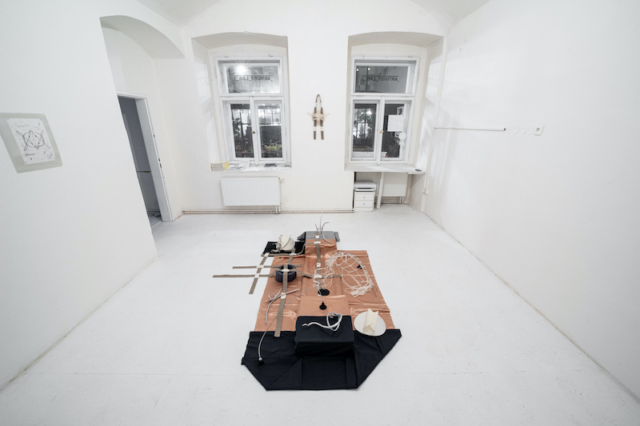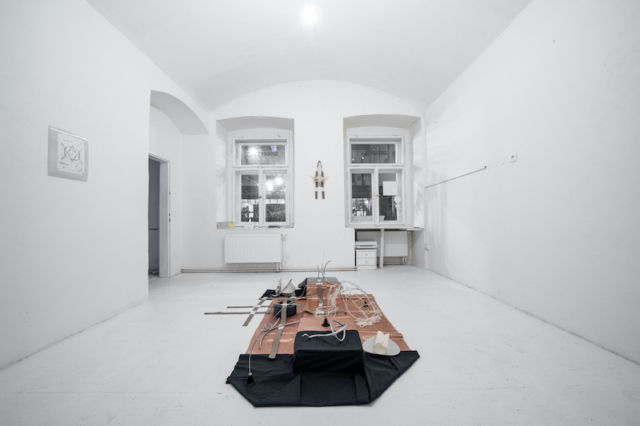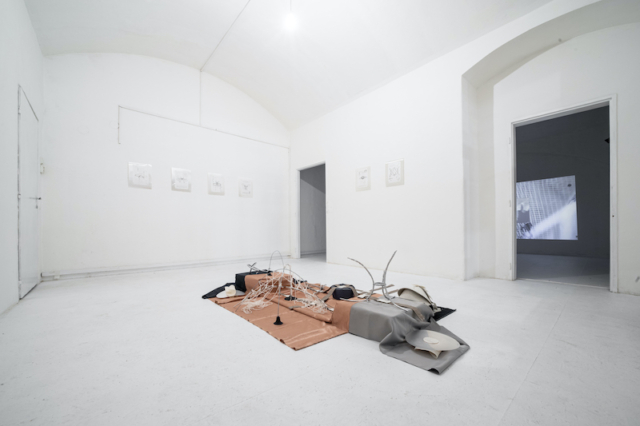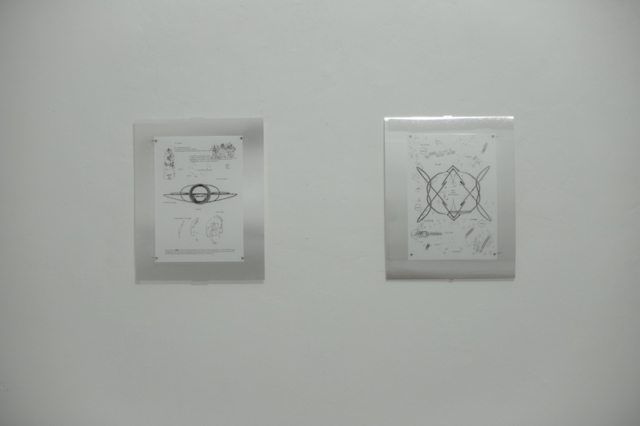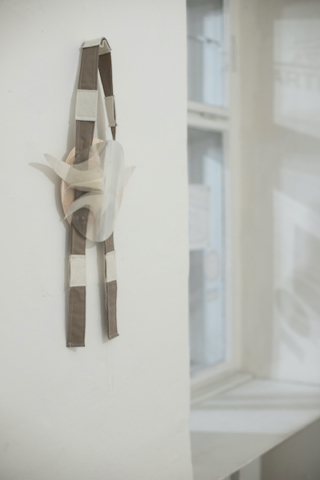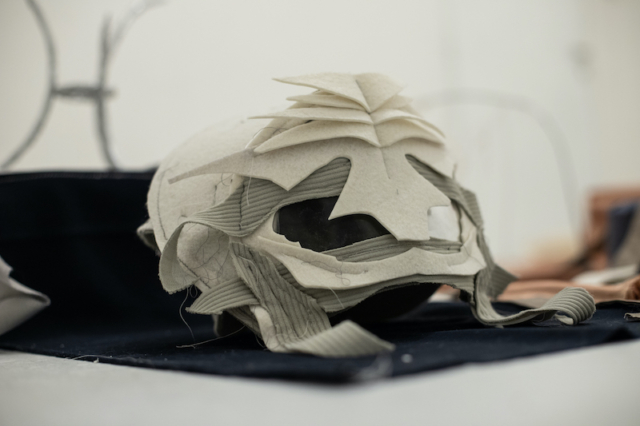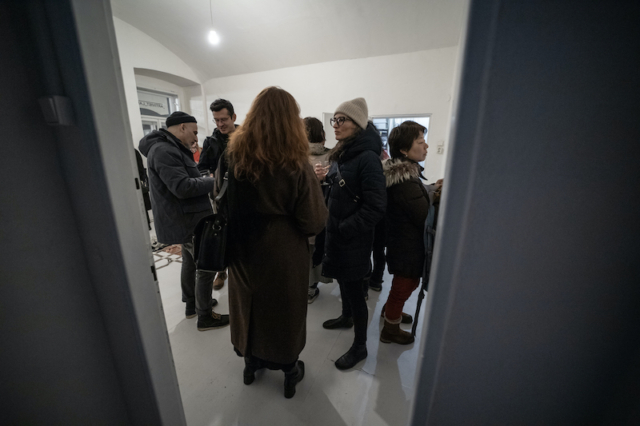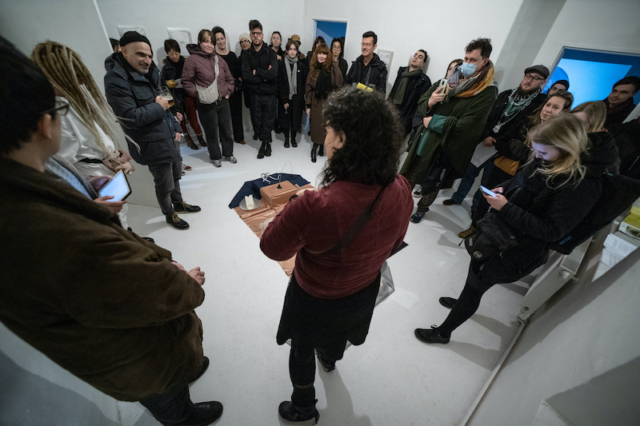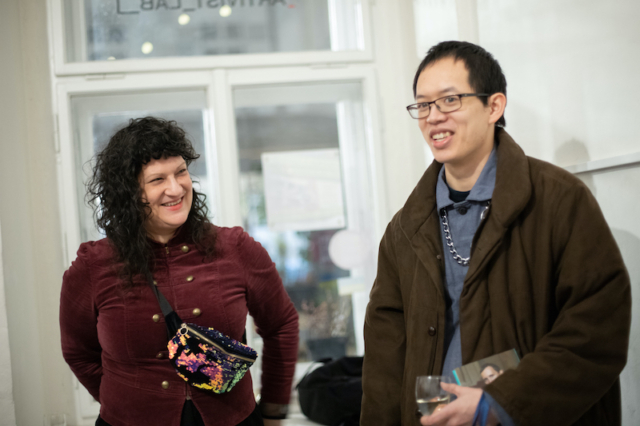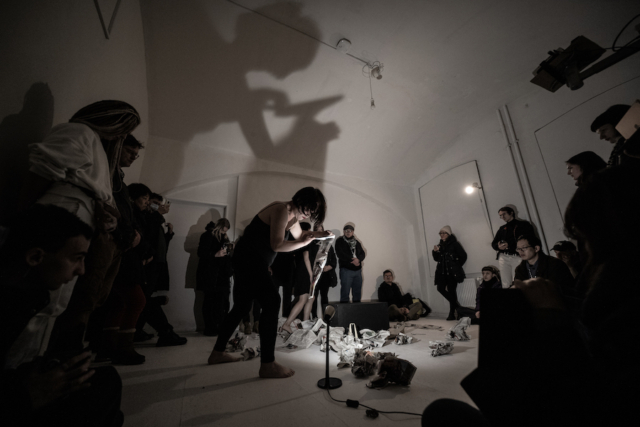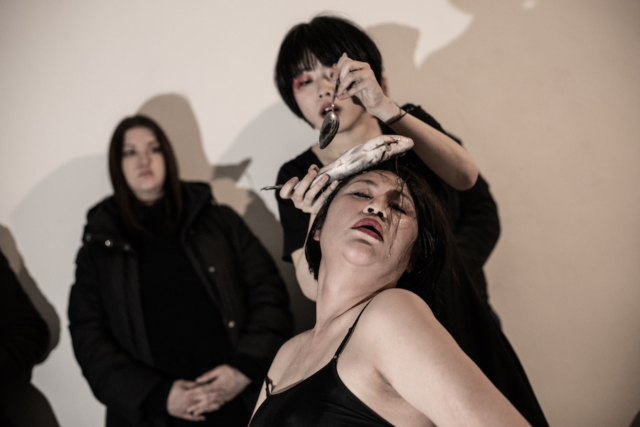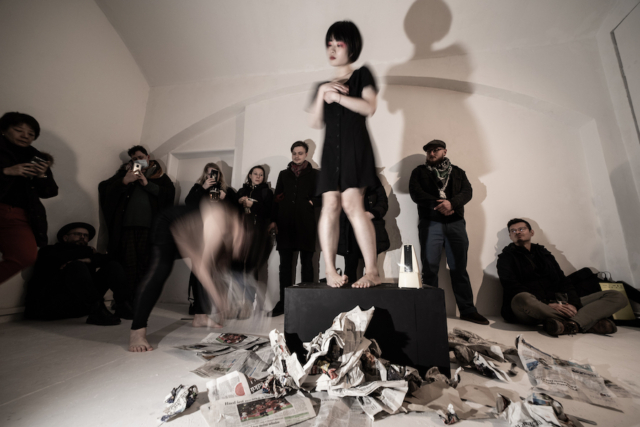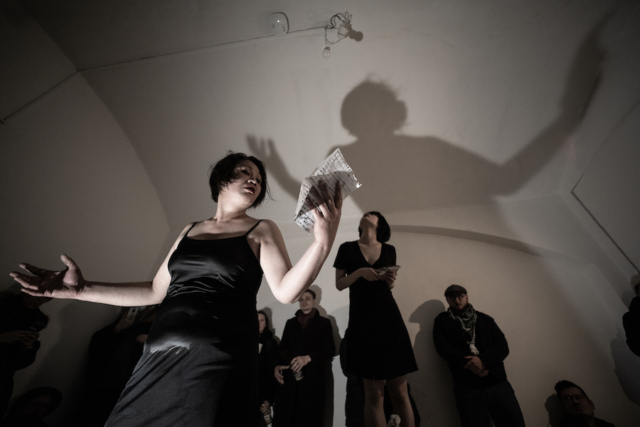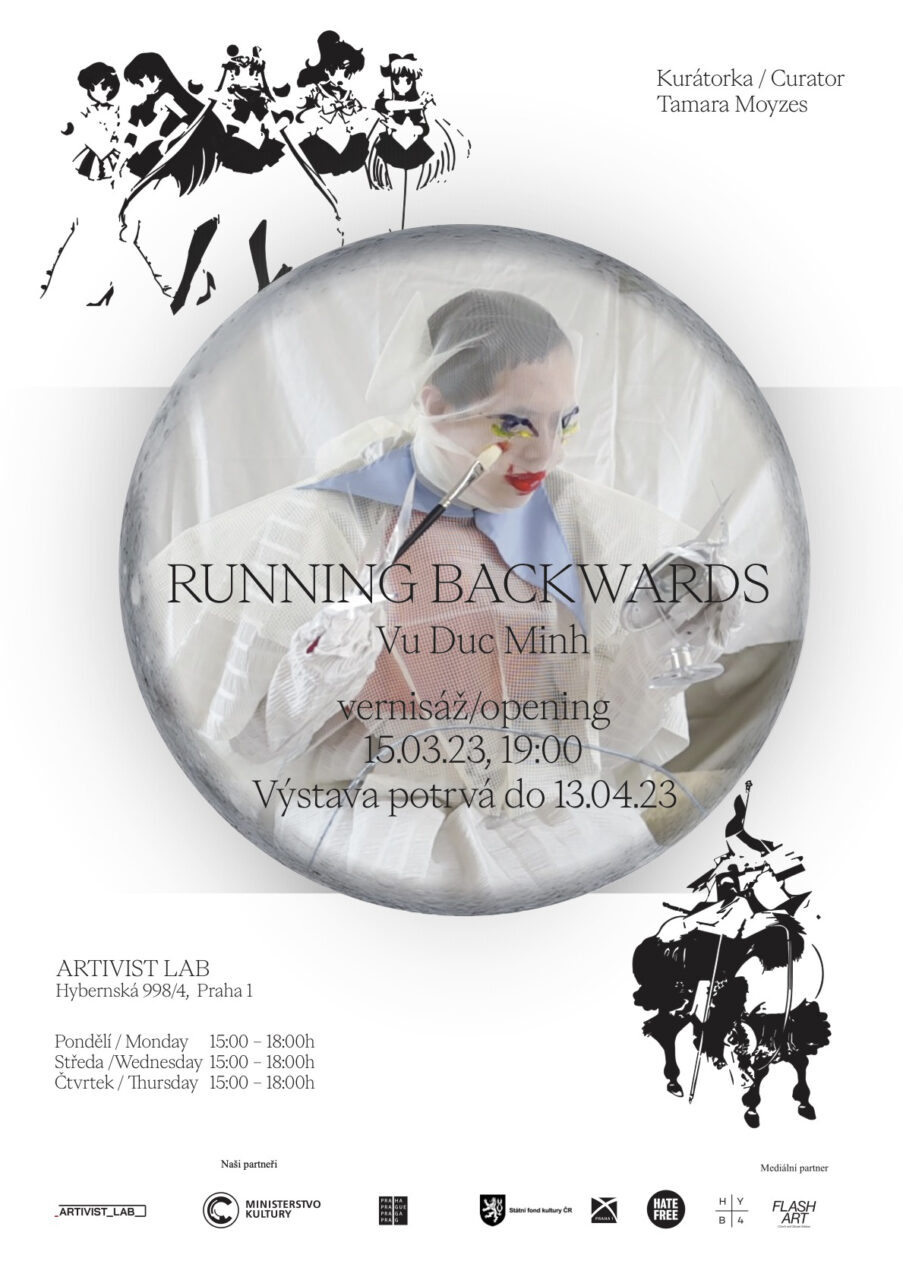Duc Minh Vu
Vernisáž / Opening: 15. 03. v 19:00h.
for English scroll down
𝐃𝐮𝐜 𝐌𝐢𝐧𝐡 𝐕𝐮 ve svém díle často využívá klasické prvky k vytvoření přesahu mezi soukromou a veřejnou sférou nebo naopak mezi politickým a soukromým. Ve svém nejnovějším díle “Running Backwards” se autor zaměřuje na transmogrifikaci těla a zpochybňuje interpretaci proměny různými kulturami. Při tomto zkoumání pracuje s prvky času v rámci lunárního cyklu a prostoru a s myšlenkou cenzury a maskování queer těla ve vztahu k japonskému manga a anime seriálu “Sailor Moon”, který autor sledoval v dětství v 90. letech 20. století.
Sailor Moon byl představen západnímu publiku a přeložen do angličtiny kanadskou produkční společností Optimum. Prostřednictvím anglického dabingu a střihu videa společnost Optimum také cenzurovala scény, které byly vnímány jako “příliš queer” nebo “nevhodné pro západní děti”. Tyto cenzurované scény zpochybňovaly západní binární systém v protikladu k fluidním sexuálním identitám a podkopávaly západní heterosexuální model; nebo jak Rhea Ashley Hoskinová naznačila ve svém článku o westernizaci a transmogrifikaci Sailor Moon: “Seriál poskytl něco, co by se dalo interpretovat jako odpor vůči dichotomickému pojetí sexuality, pohlaví a genderu, kdy queer postavy nelze převést na dichotomické západní myšlení”.
Umělec odhaluje tyto ” neúnosné” scény zrcadlením a porovnáváním titulkované verze s dabovanou anglickou verzí na vizuální časové ose lunárního cyklu; proměňuje své skryté a omezené pohyby těla ve fluidní identitu pomocí svých malířských dovedností k redefinici nové fyziognomie a obrácení střihu videa; obrácení, které symbolizuje modifikaci a přechod těla z jedné genderové formy do druhé; a stejně jako ve filmu Sailor Moon, i zde si přechod postavy či zvěda ze zemské do měsíční podoby nárokuje proměnu zvědova pohlaví, sexuality a sexuální přitažlivosti.
Duc Minh Vu ve svých digitálních tiscích převádí fyzickou povahu prostoru a času lunárního cyklu do 3D objektů, které si lze představit jako rekvizity šité na míru anime seriálu. Umísťuje je na druhy diagramů se symboly výroků a akcí inspirovaných japonskou literaturou 6. až 12. století: Torikaebaya Monogatari a Tosa Nikki, které pojednávají o pojmu transmogrifikace a stírají hranice pohlaví a sexuality. První z nich vypráví příběh dvou identických sourozenců, bratra a sestry, pocházejících od různých matek, kteří mají chování opačného pohlaví, a druhý, deník Tosa, napsaný mužským autorem, který deník rámuje z pohledu fiktivní vypravěčky.
V diskusi o kulturních rozdílech odhaluje autor otevřenost a postoj Dálného východu k fluidní identitě v kontrastu se západní kulturou, a to prostřednictvím mainstreamového vnímání komerční televize pro mládež s hodnocením dekády 90. let. Čas a sexualitu porovnává s lunárním cyklem a klade si otázku, zda se naše společnost někdy nepohybuje spíše dozadu než dopředu.
Text: Shlomi Yaffe and Tamara Moyzes
𝐃𝐮𝐜 𝐌𝐢𝐧𝐡 𝐕𝐮 se narodil v roce 1995 v Hofu (SRN) a žije a pracuje v České republice. V současné době studuje na Akademii výtvarných umění v Praze v ateliéru Intermédia II pod vedením Dušana Záhoranského a Pavly Scerankové. Ve své tvorbě se zabývá osobními tématy ve vztahu k okolnímu světu. Aktuálně je stipendistou Akademie výtvarných umění v Drážďanech.
Foto: Josef Rabara
▶︎Během vernisáže proběhne performance japonské umělkyně 𝐀𝐫𝐚𝐭𝐚-𝐀𝐥𝐢𝐜𝐢𝐚 𝐊𝐢𝐭𝐚𝐦𝐮𝐫𝐚▶︎
𝐀𝐫𝐚𝐭𝐚-𝐀𝐥𝐢𝐜𝐢𝐚 𝐊𝐢𝐭𝐚𝐦𝐮𝐫𝐚 je japonská divadelní režisérka, performerka a nezávislá badatelka. Bývalá umělecká ředitelka souboru “théâtre années folles” a členka správní rady skupiny New Project Group Mezinárodního divadelního institutu. Vystudovala obor historie na Meiji University v Tokiu a získala magisterský titul v oboru umění na Drama School of the Yale University v americkém Connecticutu. Japonská vláda jí udělila dvouletý rezidenční program v Národním divadle v Praze. Konkrétně se zaměřila na vytváření jevištních postav s biografickou politikou zahrnující problematiku postkolonializmu, chybějících kultur a queer identit.
Kurátorka: Tamara. Moyzes
Foto: Josef Rabara
Partneři: MKČR, MHMP, SFK, Praha 1, Kampus Hybernská, Hate Free, Flash Art
Running Backwards
Duc Minh Vu
In his work, 𝐃𝐮𝐜 𝐌𝐢𝐧𝐡 𝐕𝐮 often uses classical elements to create an overlap between the private and public spheres, or vice versa, between the political and the private. In his latest work ‘Running Backwards’, the artist focuses on the transmogrification of the body and questions the interpretation of transformation by different cultures. For this exploration, he works with elements of time within the lunar cycle and space, and with the idea of censorship in relation to the Japanese manga and anime series “Sailor Moon”, which the artist watched during his childhood in the 1990s.
Sailor Moon was introduced to western audiences and translated into English by Optimum, a Canadian production company. Through English dubbing and video editing, Optimum also censored scenes that were perceived as too queer or inappropriate for Western children. These censored scenes challenged the Western binary system as opposed to fluid sexual identities and undermined the Western heterosexual matrix; or as Rhea Ashley Hoskin suggested in her paper on the Westernization and Transmogrification of Sailor Moon: “The series offered what could be interpreted as resistance to dichotomous conceptualizations of sexuality, sex, and gender”, and where the queer characters cannot be translated into dichotomous Western thought.
The artist is exposing these ‘unbearable’ scenes by mirroring and comparing the subtitled version to the dubbed English version on a visual of a lunar cycle timeline; transforming his masked and limited body movements into a fluid identity by using his painting skills to redefine a new physiognomy and by inverting the video editing; inversion which symbolizes the modification and transportation of the body from one gender form to another; and as per Sailor Moon, the transportation of the character or the scout from earth form to the moon form also claim a transformation of the scout’s gender, sexuality and sexual attraction.
In his digital prints, Duc Minh Vu translates the physical nature of space and time on the lunar cycle into 3D objects that could be imagined as tailor-made props for the anime series. He places them on chart types with signs of statements and actions inspired by Japanese literature from the 6th to the 12th centuries: Torikaebaya Monogatari and the Tosa Nikki, which discuss the notion of transmogrification and blur the boundaries of gender and sexuality; one tells the story of two identical siblings, a brother, and a sister, from different mothers who have the mannerisms of the opposite sex, and the other, the Tosa diary, written by a male author who frames the diary from the point of view of a fictional female narrator.
By discussing cultural differences, the artist reveals the openness and attitude of the Far East towards fluid identity, in contrast to Western culture, through the mainstream perception of commercial youth television evaluating the decade of the 1990s. He measures time and sexuality against the lunar cycle and wonders whether our society sometimes moves backward rather than forwards.
𝐃𝐮𝐜 𝐌𝐢𝐧𝐡 𝐕𝐮 was born in 1995 in Hof (GER) and lives and works in the Czech Republic. He is currently studying at the Academy of Fine Arts in Prague in the Intermedia II studio under the direction of Dušan Záhoranský and Pavla Sceranková. His works deal with personal themes in relation to the outside world. He is currently a scholarship holder at the Dresden Academy of Fine Arts.
▶︎During the opening, there will be a performance by the Japanese artist Arata-Alicia Kitamura ◀︎
𝐀𝐫𝐚𝐭𝐚-𝐀𝐥𝐢𝐜𝐢𝐚 𝐊𝐢𝐭𝐚𝐦𝐮𝐫𝐚, is a Japanese Theater director, performance artist, and independent scholar. Former artistic director of « théâtre années folles » and a board of the New Project Group of the International Theater Institute. She graduated history major at Meiji University, Tokyo, and gain a Master’s degree in Art at the Drama School of Yale University, Connecticut US. She was awarded a residency program at the National Theater in Prague by the Japanese government for two years. She has specifically focused on creating stage figures with biographical politics including issues of post-colonial, missing cultures, and queer identities.
Glossary:
The ‘Sailor Moon’ anime series from the 1990s was brought to the western market by the production company Optimum.
The 2014 ‘Sailor Moon’ anime series was introduced to the western market by the Wismedia company and was not fully censored.
The characters in the manga series are called ‘Pretty Soldiers’.
The characters in the anime series are called ‘Scouts’ in the 1990s version and ‘Guardians’ in the latest 2014 version.
text by: Tamara Moyzes and Shlomi Yaffe

